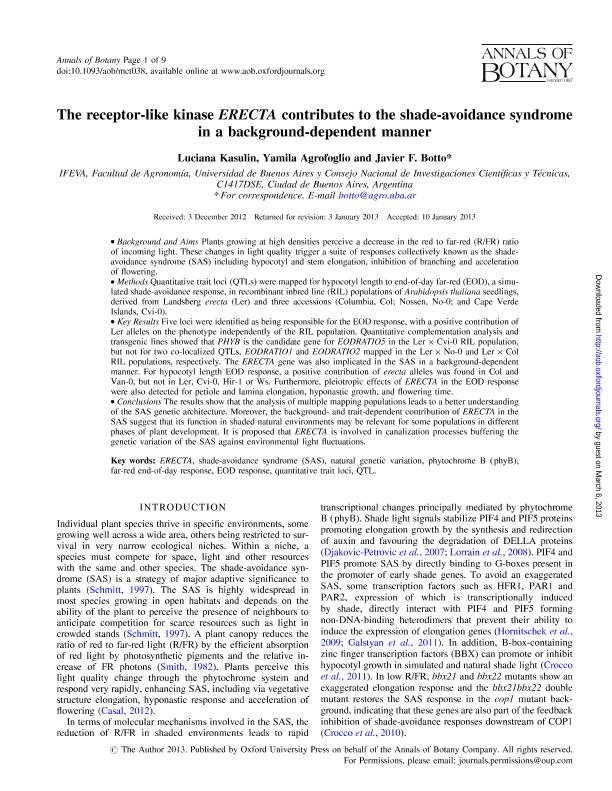Mostrar el registro sencillo del ítem
dc.contributor.author
Kasulin, Luciana

dc.contributor.author
Agrofoglio, Yamila Carla
dc.contributor.author
Botto, Javier Francisco

dc.date.available
2016-02-22T17:18:05Z
dc.date.issued
2013-02
dc.identifier.citation
Kasulin, Luciana; Agrofoglio, Yamila Carla; Botto, Javier Francisco; The receptor-like kinase ERECTA contributes to the shade-avoidance syndrome in a background-dependent manner; Oxford University Press; Annals of Botany; 111; 2-2013; 811-819
dc.identifier.issn
0305-7364
dc.identifier.uri
http://hdl.handle.net/11336/4342
dc.description.abstract
Background and Aims Plants growing at high densities perceive a decrease in the red to far-red (R/FR) ratio of incoming light. These changes in light quality trigger a suite of responses collectively known as the shade-avoidance syndrome (SAS) including hypocotyl and stem elongation, inhibition of branching and acceleration of flowering.
Methods Quantitative trait loci (QTLs) were mapped for hypocotyl length to end-of-day far-red (EOD), a simulated shade-avoidance response, in recombinant inbred line (RIL) populations of Arabidopsis thaliana seedlings, derived from Landsberg erecta (Ler) and three accessions (Columbia, Col; Nossen, No-0; and Cape Verde Islands, Cvi-0).
Key Results Five loci were identified as being responsible for the EOD response, with a positive contribution of Ler alleles on the phenotype independently of the RIL population. Quantitative complementation analysis and transgenic lines showed that PHYB is the candidate gene for EODRATIO5 in the Ler × Cvi-0 RIL population, but not for two co-localized QTLs, EODRATIO1 and EODRATIO2 mapped in the Ler × No-0 and Ler × Col RIL populations, respectively. The ERECTA gene was also implicated in the SAS in a background-dependent manner. For hypocotyl length EOD response, a positive contribution of erecta alleles was found in Col and Van-0, but not in Ler, Cvi-0, Hir-1 or Ws. Furthermore, pleiotropic effects of ERECTA in the EOD response were also detected for petiole and lamina elongation, hyponastic growth, and flowering time.
Conclusions The results show that the analysis of multiple mapping populations leads to a better understanding of the SAS genetic architecture. Moreover, the background- and trait-dependent contribution of ERECTA in the SAS suggest that its function in shaded natural environments may be relevant for some populations in different phases of plant development. It is proposed that ERECTA is involved in canalization processes buffering the genetic variation of the SAS against environmental light fluctuations.
dc.format
application/pdf
dc.language.iso
eng
dc.publisher
Oxford University Press

dc.rights
info:eu-repo/semantics/openAccess
dc.rights.uri
https://creativecommons.org/licenses/by-nc-sa/2.5/ar/
dc.subject
Erecta
dc.subject
Shade-Avoidance Syndrome (Sas)
dc.subject
Natural Genetic Variation
dc.subject
Phytochrome B (Phyb)
dc.subject
Far-Red End-Of-Day Response
dc.subject
Eod Response
dc.subject
Quantitative Trait Loci
dc.subject
Qtl
dc.subject.classification
Ciencias de las Plantas, Botánica

dc.subject.classification
Ciencias Biológicas

dc.subject.classification
CIENCIAS NATURALES Y EXACTAS

dc.title
The receptor-like kinase ERECTA contributes to the shade-avoidance syndrome in a background-dependent manner
dc.type
info:eu-repo/semantics/article
dc.type
info:ar-repo/semantics/artículo
dc.type
info:eu-repo/semantics/publishedVersion
dc.date.updated
2016-03-30 10:35:44.97925-03
dc.journal.volume
111
dc.journal.pagination
811-819
dc.journal.pais
Reino Unido

dc.journal.ciudad
Oxford
dc.description.fil
Fil: Kasulin, Luciana. Consejo Nacional de Investigaciones Científicas y Técnicas. Oficina de Coordinación Administrativa Parque Centenario. Instituto de Investigaciones Fisiológicas y Ecológicas Vinculadas A la Agricultura; Argentina
dc.description.fil
Fil: Agrofoglio, Yamila Carla. Consejo Nacional de Investigaciones Científicas y Técnicas. Oficina de Coordinación Administrativa Parque Centenario. Instituto de Investigaciones Fisiológicas y Ecológicas Vinculadas A la Agricultura; Argentina
dc.description.fil
Fil: Botto, Javier Francisco. Consejo Nacional de Investigaciones Científicas y Técnicas. Oficina de Coordinación Administrativa Parque Centenario. Instituto de Investigaciones Fisiológicas y Ecológicas Vinculadas A la Agricultura; Argentina
dc.journal.title
Annals of Botany

dc.relation.alternativeid
info:eu-repo/semantics/altIdentifier/doi/http://dx.doi.org/10.1093%2Faob%2Fmct038
dc.relation.alternativeid
info:eu-repo/semantics/altIdentifier/url/http://aob.oxfordjournals.org/content/111/5/811.long
Archivos asociados
